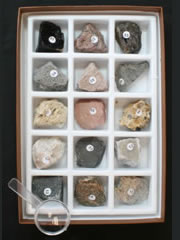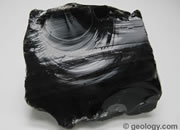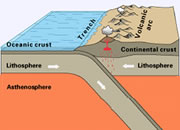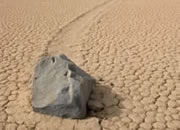Shale
Shale is the most abundant sedimentary rock and is in sedimentary basins worldwide.
What is Shale?Shale is a fine-grained sedimentary rock that forms from the compaction of silt and clay-size mineral particles that we commonly call "mud". This composition places shale in a category of sedimentary rocks known as "mudstones". Shale is distinguished from other mudstones because it is fissile and laminated. "Laminated" means that the rock is made up of many thin layers. "Fissile" means that the rock readily splits into thin pieces along the laminations. Uses of ShaleSome shales have special properties that make them important resources. Black shales contain organic material that sometimes breaks down to form natural gas or oil. Other shales can be crushed and mixed with water to produce clays that can be made into a variety of useful objects. Conventional Oil and Natural Gas
The oil and natural gas migrated out of the shale and upwards through the sediment mass because of their low density. The oil and gas were often trapped within the pore spaces of an overlying rock unit such as a sandstone (see illustration at right). These types of oil and gas deposits are known as "conventional reservoirs" because the fluids can easily flow through the pores of the rock and into the extraction well. Although drilling can extract large amounts of oil and natural gas from the reservoir rock, much of it remains trapped within the shale. This oil and gas is very difficult to remove because it is trapped within tiny pore spaces or adsorbed onto clay mineral particles that make-up the shale. Unconventional Oil and Natural GasIn the late 1990s natural gas drilling companies developed new methods for liberating oil and natural gas that is trapped within the tiny pore spaces of shale. This discovery was significant because it unlocked some of the largest natural gas deposits in the world. The Barnett Shale of Texas was the first major natural gas field developed in a shale reservoir rock. Producing gas from the Barnett Shale was a challenge. The pore spaces in shale are so tiny that the gas has difficulty moving through the shale and into the well. Drillers discovered that they could increase the permeability of the shale by pumping water down the well under pressure that was high enough to fracture the shale. These fractures liberated some of the gas from the pore spaces and allowed that gas to flow to the well. This technique is known as "hydraulic fracturing" or "hydrofracing". Drillers also learned how to drill down to the level of the shale and turn the well 90 degrees to drill horizontally through the shale rock unit. This produced a well with a very long "pay zone" through the reservoir rock (see illustration at right). This method is known as "horizontal drilling". Horizontal drilling and hydraulic fracturing revolutionized drilling technology and paved the way for developing several giant natural gas fields. These include the Marcellus Shale in the Appalachians, the Haynesville Shale in Louisiana and the Fayetteville Shale in Arkansas. These enormous shale reservoirs hold enough natural gas to serve all of the United States' needs for twenty years or more. Shale Used to Produce ClayEveryone has contact with products made from shale. If you live in a brick house, drive on a brick road, live a house with a tile roof or keep plants in "terra cotta" pots you have daily contact with items that were probably made from shale. Many years ago these same items were made from natural clay. However, heavy use depleted most of the small clay deposits. Needing a new source of raw materials, manufacturers soon discovered that mixing finely ground shale with water would produce a clay that often had similar or superior properties. Today, most items that were once produced from natural clay have been replaced by almost identical items made from clay manufactured by mixing finely ground shale with water. Shale Used to Produce CementCement is another common material that is often made with shale. To make cement, crushed limestone and shale are heated to a temperature that is high enough to evaporate off all water and break down the limestone into calcium oxide and carbon dioxide. The carbon dioxide is lost as an emission but the calcium oxide combined with the heated shale makes a powder that will harden if mixed with water and allowed to dry. Cement is used to make concrete and many other products for the construction industry. Oil ShaleOil shale is a rock that contains significant amounts of organic material in the form of kerogen. Up to 1/3 of the rock can be solid kerogen. Liquid and gaseous hydrocarbons can be extracted from oil shale but the rock must be heated and/or treated with solvents. This is usually much less efficient than drilling rocks that will yield oil or gas directly into a well. Extracting the hydrocarbons from oil shale produces emissions and waste products that cause significant environmental concerns. This is one reason why the world's extensive oil shale deposits have not been aggressively utilized.Oil shale usually meets the definition of "shale" in that it is "a laminated rock consisting of at least 67% clay minerals," however; it sometimes contains enough organic material and carbonate minerals that clay minerals account for less than 67% of the rock. Composition of ShaleShale is a rock composed mainly of clay-size mineral grains. These tiny grains are usually clay minerals such as illite, kaolinite and smectite. Shale usually contain other clay-size mineral particles such as quartz, chert and feldspar. Other constituents might include organic particles, carbonate minerals, iron oxide minerals, sulfide minerals and heavy mineral grains. These "other constituents" in the rock are often determined by the shale's environment of deposition and often determine the color of the rock. Colors of ShaleLike most rocks, the color of shale is often determined by the presence of specific materials in minor amounts. Just a few percent of organic materials or iron can significantly alter the color of a rock. Black and Gray ShaleA black color in sedimentary rocks almost always indicates the presence of organic materials. Just one or two percent organic materials can impart a dark gray or black color to the rock. In addition, this black color almost always implies that the shale formed from sediment deposited in an oxygen-deficient environment. Any oxygen that entered the environment quickly reacted with the decaying organic debris. If a large amount of oxygen was present the organic debris would all have decayed. An oxygen-poor environment also provides the proper conditions for the formation of sulfide minerals such as pyrite, another important mineral found in most black shales. The presence of organic debris in black shales makes them the candidates for oil and gas generation. If the organic material is preserved and properly heated after burial oil and natural gas might be produced. The Barnett Shale, Marcellus Shale, Haynesville Shale,Fayetteville Shale and other gas producing rocks are all dark gray or black shales that yield natural gas. The Bakken Shale of North Dakota and the Eagle Ford Shale of Texas are examples of shales that yield oil. Gray shales sometimes contain a small amount of organic matter. However, gray shales can also be rocks that contain calcareous materials or simply clay minerals that result in a gray color. Red, Brown and Yellow ShaleShales that are deposited in oxygen-rich environments often contain tiny particles of iron oxide or iron hydroxide minerals such ashematite, goethite or limonite. Just a few percent of these minerals distributed through the rock can produce the red, brown or yellow colors exhibited by many types of shale. The presence of hematite can produce a red shale. The presence of limonite or goethite can produce a yellow or brown shale. Green ShaleGreen shales are occasionally found. This should not be surprising because some of the clay minerals and micas that make up much of the volume of these rocks are typically a greenish color. Hydraulic Properties of ShaleHydraulic properties are characteristics of a rock such as permeability and porosity that reflect its ability to hold and transmit fluids such as water, oil or natural gas. Shale has a very small particle size so the interstitial spaces are very small. In fact they are so small that oil, natural gas and water have difficulty moving through the rock. Shale can therefore serve as a cap rock for oil and natural gas traps and it also is an aquiclude that blocks or limits the flow of underground water. Although the interstitial spaces in a shale are very small they can take up a significant volume of the rock. This allows the shale to hold significant amounts of water, gas or oil but not be able to effectively transmit them because of the low permeability. The oil and gas industry overcomes these limitations of shale by using horizontal drilling and hydraulic fracturing to create artificial porosity and permeability within the rock. Some of the clay minerals that occur in shale have the ability to absorb or adsorb large amounts of water, natural gas, ions or other substances. This property of shale can enable it to selectively and tenaciously hold or freely release fluids or ions. Engineering Properties of Shale SoilsShales and the soils derived from them are some of the most troublesome materials to build upon. They are subject to changes in volume and competence that generally make them unreliable construction substrates. Expansive SoilsThe clay minerals in some shale-derived soils have the ability to absorb and release large amounts of water. This change in moisture content is usually accompanied by a change in volume which can be as much as several percent. These materials are called "expansive soils". When these soils become wet they swell and when they dry out they shrink. Buildings, roads, utility lines or other structures placed upon or within these materials can be weakened or damaged by the forces and motion of volume change. Expansive soils are one of the most common causes of foundation damage to buildings in the United States. Slope StabilityShale is the rock most often associated with landslides. Weathering transforms the shale into a clay-rich soil which normally has a very low shear strength - especially when wet. When these low-strength materials are wet and on a steep hillside they can slowly or rapidly move down slope. Overloading or excavation by humans will often trigger failure. Environments of Shale DepositionAn accumulation of mud begins with the chemical weathering of rocks. This weathering breaks the rocks down into clay minerals and other small particles which often become part of the local soil. A rainstorm might wash tiny particles of soil from the land and into streams, giving the streams a "muddy" appearance. When the stream slows down or enters a standing body of water such as a lake, swamp or ocean the mud particles settle to the bottom. If undisturbed and buried this accumulation of mud might be transformed into a sedimentary rock known as "mudstone". This is how most shales are formed. Contributor: Hobart King Find it on Geology.comMore from Geology.com
|










































